Throughout the 1960s, George Winter produced pioneering research that has driven the techniques used in today's practice of dressing and treating wounds. This research had proven the theory behind the moist wound healing principle and states that extensive wounds thrive and heel successfully in a sterile, moist environment, supporting the vital wound healing stages (Winter, 1962). Winter (1962) explained that epithelialisation of superficial wounds occurs at a much slower rate when covered normally by a dry scab; however, when a scab that covers a wound is prevented from forming, the rate at which epithelialisation occurs is markedly increased. Registered veterinary nurses (RVN) should have a thorough knowledge and understanding of the stages of wound healing in order to gain an insight into the specific requirements of the wound to assist the healing process. The large variety of wound dressings available in veterinary practice, it makes it essential for the RVN to understand the specific circumstances that each dressing should be applied to and how to monitor the healing process for the benefit of their patients (Figure 1). The key to successful wound management is an accurate and thorough initial assessment of the extent of the injury along with careful planning of how the wound should be addressed (Anderson, 2003; Dealey, 2005).
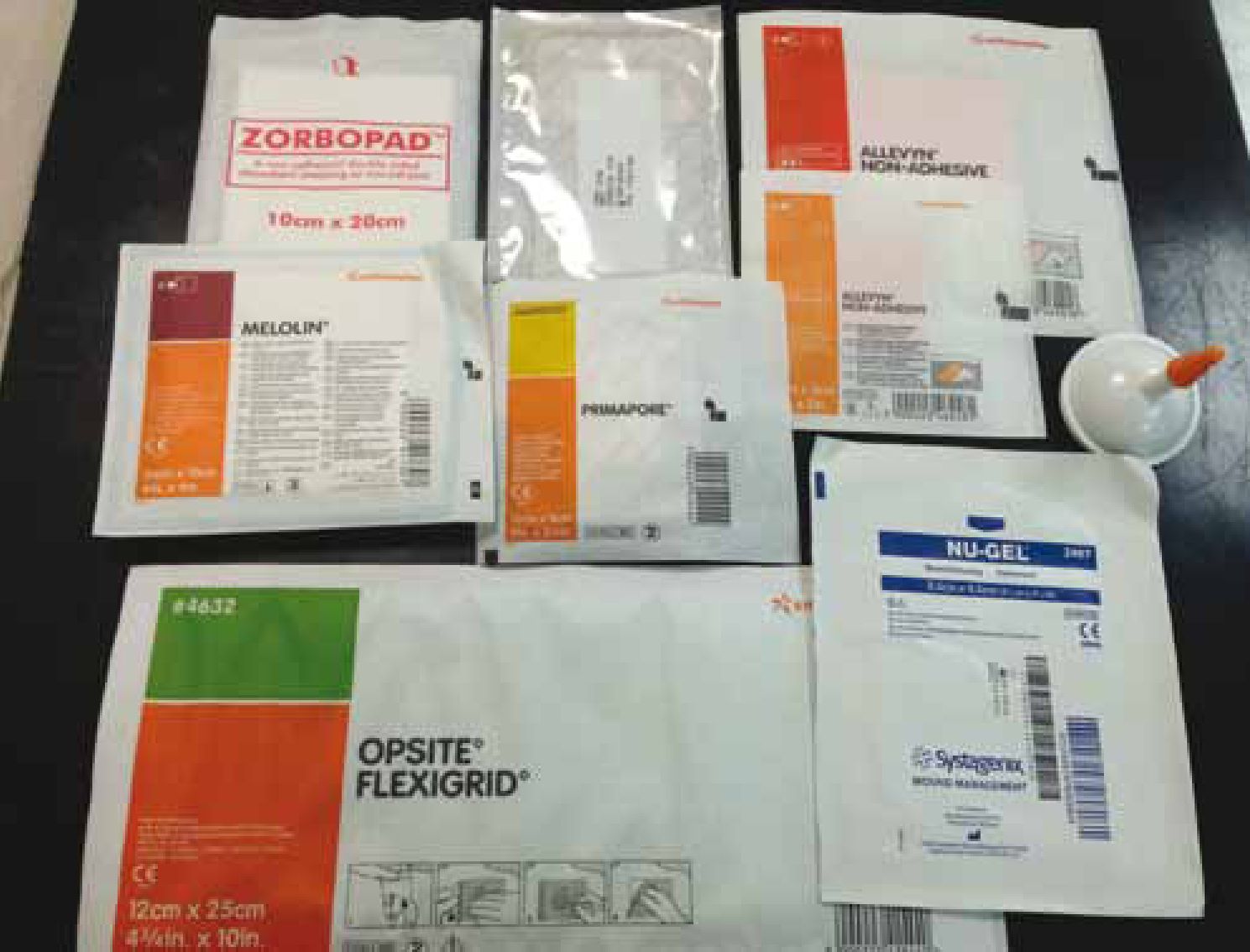
When a wound occurs, the normal integrity of the tissues becomes interrupted (Tear and Wortinger, 2012). A wide variety of wounds are seen in practice — these will usually be categorised as surgical incisions following a procedure, traumatic wounds for example, a degloving injury, or bite wounds. The healing process is a dynamic process and will commence immediately after the injury has occurred, where haemorrhage and inflammation may be evident (Bloor, 2013). Understanding the different stages involved in the healing process enables the RVN to gain an appreciation into what the ‘normal’ process should be and the timeframes involved; this understanding should also enhance the knowledge of how different wound dressings work and which type of dressing is most appropriate to support each healing phase (Anderson, 1996)(Table 1).
| Inflammatory phase (days 0–5) | Initiates inflammation of tissues Haemorrhage followed by haemostasis Produces heat, redness, swelling and pain Localised vasodilation, oedema and serous-type ooze |
| Debridement phase (from day 0) | Migration of leucocytes Phagocytosis occurs, removing and destroying bacteria Cellular debris is removed |
| Proliferative phase (day 3 up to 4 weeks) | Repair of damaged tissues Formation of a repair ‘framework’ and granulation tissue Wound contraction and epithelialisation |
| Remodelling phase (day 20 to years) | Repaired tissue is replaced by collagen Wound continues to contract Tissue regains some elasticity and protective barrier function |
Role of wound dressings
All wounds should be closely monitored throughout the healing process as different types of wound dressings may be required at different points while the wound heals. Each of the different wound dressings available have a specific function and it is up to the veterinary surgeon and the RVN to establish which dressing is most appropriate to facilitate good wound management. A wound management article written by Anderson (2003) details the use of specific questions the clinician should ask when evaluating wounds to enable a thorough assessment (Table 2). It should be established if the wound is still inflamed, displaying clinical signs of gross contamination, infection or necrotic tissue. If so, perhaps it would be beneficial for the wound to undergo further debridement to remove the debris/necrotic tissue; furthermore, the wound dressing applied should be effective for absorbing and drawing exudates away from the wound along with preventing infection (Orpet and Welsh, 2011). It would prove valuable to confirm whether granulation tissue is present and how well it is forming — consideration must be given to the delicate structures of the granulation tissue and its progression should not be disturbed (Figure 2). The ideal dressing to promote granulation tissue formation would be one that provides an appropriate environment — it should be non restrictive, non adherent and sterile, and provide a moist environment to accelerate the healing process. Establishing if the granulation tissue is fresh or chronic is also vital as chronic granulation tissue will require a dressing that actively debrides the tissue and helps to re-stimulate growth of healthy granulation tissue (Anderson, 2003). Finally, an overall evaluation should be performed to determine how the wound is progressing through the healing phases; static, non-healing wounds will require further investigations to determine the cause of wound healing failure or breakdown. It may prove beneficial to measure and record the size of larger and extensive wounds at each dressing change to monitor the contraction and healing of the wound.
| 1. | Is inflammation present? |
| 2. | Is there gross contamination of the wound? |
| 3. | Is there infected or necrotic tissue present? |
| 4. | Does the wound require further debridement? |
| 5. | Is there granulation tissue present? |
| 6. | How well is the granulation tissue forming? |
| 7. | Is the granulation tissue fresh or chronic? |
| 8. | How static does the wound appear? |
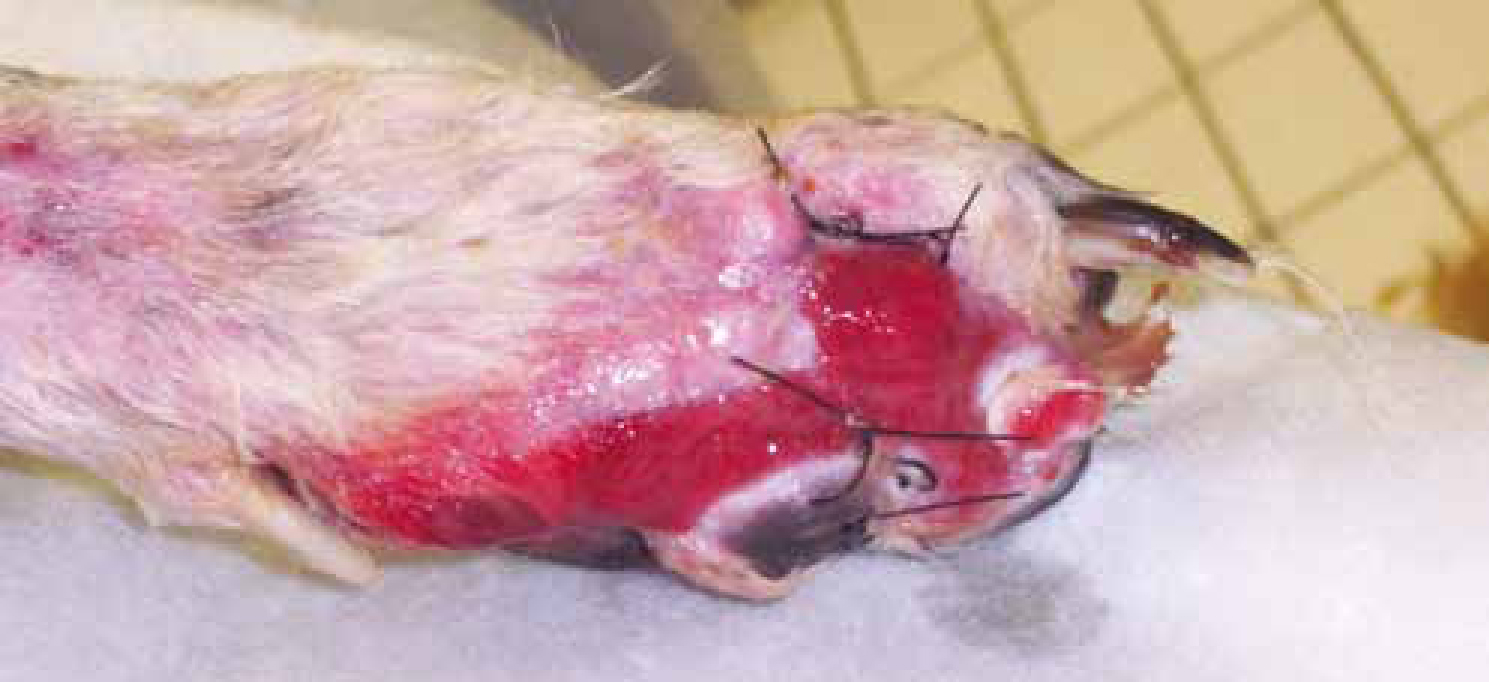
Dressing changes should take place on a more frequent basis throughout the early stages than the later stages to achieve effective wound management; some authors recommend that dressings should be changed once or twice a day for the first few days particularly if debridement dressings, e.g. wet-to-dry, are being used, or more often if visible soiling occurs (Dealey, 2005, Orpet and Welsh, 2011). By performing regular dressing changes and thorough wound evaluation during the early stages, it is possible to determine how often a dressing change should take place for the benefit and health of the healing wound.
Types of wound dressings
Adherent (debridement) dressings
Wound dressings that fall into the category of adherent or debridement have a primary function to control wound infection and debride infected or necrotic wounds. The terms ‘wet-to-dry’ and ‘dry-to-dry’ are associated with this method of wound dressing and commonly involve the application of saline-soaked or dry, sterile gauze swabs directly on the wound's surface to achieve this (Figure 3).
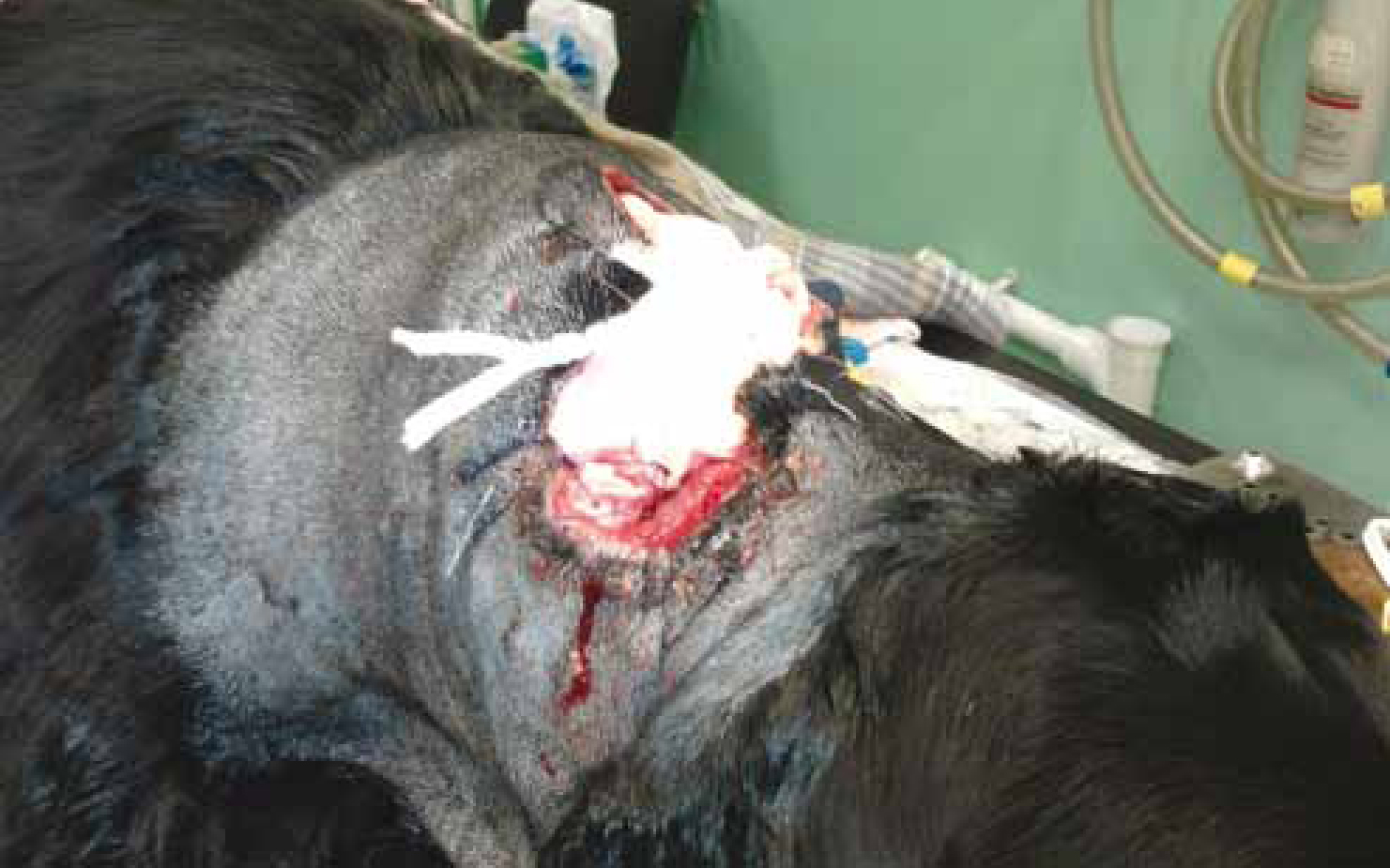
The main purpose of placing a debridement dressing is to encourage removal of necrotic tissue/debris and the primary layer should adhere to the wound bed and dry out, so that when the dressing is removed, the debris/bacteria is then removed with it (O'Dwyer, 2007, Orpet and Welsh, 2011). This type of wound dressing should ideally be changed at least every 24 hours as the exudates are absorbed into the gauze and the dressing will remove most debris or necrotic tissue when it is peeled away; fresh granulation tissue should be handled carefully to avoid compromising the progression of the wound. It would be beneficial to note that this form of dressing can be painful to remove from patients, therefore analgesia and possible sedation should be considered (Anderson, 2003).
Non-adherent dressings
There are numerous subcategories under the group of non-adherent dressings and the dressings generally vary in their adherence.
Perforated polyurethane membranes
Perforated polyurethane membrane dressings include Melolin (Smith & Nephew) and Primapore (Smith & Nephew) which comprise a thin perforated polyurethane membrane; the dressings in this category vary in absorbency (Figure 4). This type of simple wound dressing is usually applied to, for example, a post-operative wound where the incision site and sutures require protection throughout the immediate post-operative period. Perforated polyurethane dressings should not be used in granulating wounds as they lack the ability to provide the ideal healing environment for the granulation process and may disrupt the healing wound on removal (Orpet and Welsh, 2011).
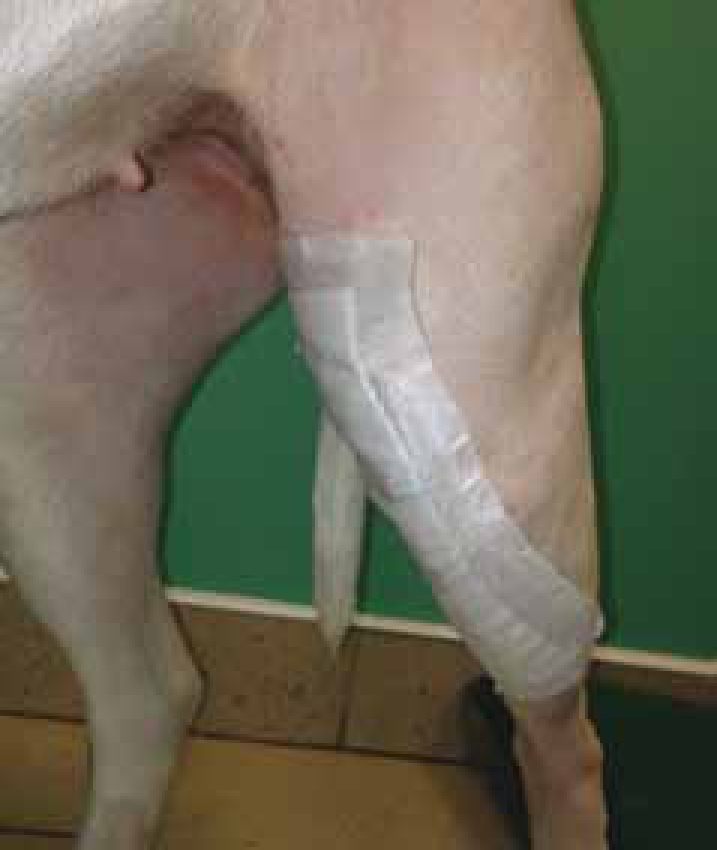
Paraffin gauzes
Paraffin gauze dressings comprise a thin, cotton netting impregnated with soft paraffin which is applied directly over the open wound as a primary layer; this form of wound dressing should include a secondary layer above the gauze to act as an absorbent layer to draw exudates away from the wound. The volume of paraffin found on these types of dressing may vary between brands; Anderson (2003) has suggested it leaves a thick, difficult to remove residue in the wound with the potential to become occlusive to the exudates leaving the wound. The main principle behind the paraffin is to prevent the dressing sticking to the wound and to support healing under moist and aseptic conditions. Paraffin gauze dressings are most suited to superficial skin wounds, burns, skin graft sites and traumatic injuries where skin loss is evident (Smith & Nephew, 2013).
Vapour permeable films
Wound dressings such as Opsite Flexigrid (Smith & Nephew) fall under the vapour permeable film category of dressing and their main functions are to promote moist wound healing and provide a protective barrier. Vapour permeable dressings are only suitable for small or shallow wounds producing little exudate as this becomes trapped underneath the dressing. The thin, conformable membrane of these dressings should be stretched over the wound, with the edges sticking to the skin surface, which may prove a little tricky to apply. The dressing allows for vapour exchange at the wound surface whilse-maintaining an ideal moist environment for the wound.
Absorbent dressings
Absorbent dressings have the primary function of providing an absorbent layer for wounds producing high volumes of exudate, such as large, extensive wounds undergoing the granulation process.
Foams are highly absorbent dressings and act by absorbing wound exudates while maintaining a moist environment suitable for granulation and epithelialisation to take place. Such dressings include Allevyn (Smith & Nephew) and Tielle (Johnson & Johnson) and they have the additional benefit of providing a protective barrier over the wound. The outer layer of foam dressings help to prevent strike through and Anderson (2003) has stated that these wound dressings can absorb up to 10 times their own weight. It would also be beneficial to note that foam dressing do not hold any debriding properties, therefore an alternative dressing should be considered if this is to be achieved.
Super-absorbent dressings are also available for wounds that are experiencing large volumes of exudates and moisture management may be proving tricky. Eclypse (Advancis Medical) is an example of a super-absorbent dressing, designed to help control highly exuding wounds while maintaining the optimum wound healing environment. Cook (2011) describes these dressings as having differing properties to those of traditional foam dressings, as they are able to significantly swell as it absorbs the exudates. Super-absorbent dressings contain polyacrylate polymers which posess hydroactive properties, enabling them to hold and retain large volumes of fluid (Ousey et al, 2013).
Active dressings
Active dressings serve the purpose of gently debriding the wound's surface, providing a moist wound environment and encouraging wound granulation. The two major dressing types that fall under this category include hydrocolloids and hydrogels.
Hydrocolloids
Granuflex (ConvaTec) and Tegasorb (3M Healthcare) are two examples of hydrocolloid dressings and these consist of a microgranular layer of natural or synthetic polymers (gelatin, pectin or carboxymethyl-cellulose) within an adhesive polymer matrix (Anderson, 2003). They usually contain a semipermeable, outer membrane and have an antioxidant property by releasing small quantities of hydrogen peroxide, which assists in minimising cellular metabolism and proliferation. Hydrocolloid dressings will absorb and hold the wound exudates, and in doing so, pressure is exerted on the wound bed as it becomes packed by the absorbent hydrocolloid. Wounds displaying chronic granulation tissue or necrotic tissue benefit greatly from hydrocolloid dressings; however, the wound must be monitored closely for healthy granulation tissue to establish how it is reacting to these dressings. The wound may become slightly enlarged due to the debridement properties of hydrocolloids. It would be worth noting that hydrocolloids should be used with caution in the presence of infection, therefore making them unsuitable for the early stages of wound debridement (Dealey, 2005).
Hydrogels
Intrasite Gel (Smith & Nephew) and Nugel (Johnson & Johnson) are examples of hydrogels that are available in tubes of gel that can be applied directly to the wound surface (Figure 5). When applied to a wound, the hydrogel should be covered with a semipermeable adhesive layer to maintain a moist environment. The debriding action of hydrogels is considered as atraumatic in comparison to wet-to-dry or surgical debridement, with minimal pain experienced during the application of, and removal from the patient; their debriding properties enables use within infected wounds and they will actively assist in removing bacteria and debris from the wound (Anderson, 2003). Hydrogels will encourage the formation of granulation tissue and there is also evidence to suggest that their application in human medicine provides a form of analgesia, especially when applied cold (Dealey, 2005).
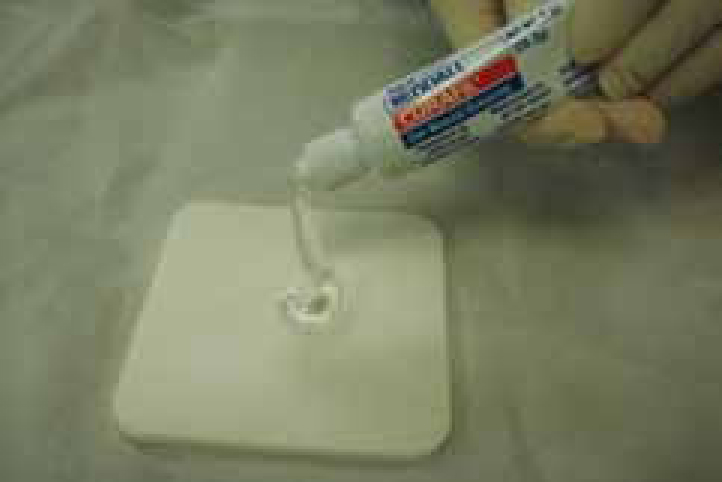
Antimicrobial dressings
Over recent years, dressings exhibiting anti-microbial properties have become a popular method of managing wounds where delayed healing and chronic infection are an issue (Figure 6).
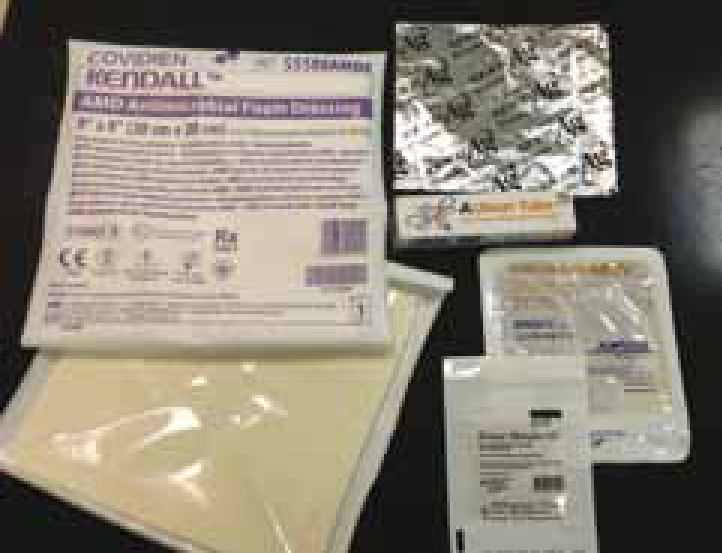
Silver dressings
Dressings impregnated with silver have been renowned for their antibacterial properties and there are a growing variety of silver dressings available for use in veterinary practice. Such dressings include Acticoat (Smith & Nephew) and Silvercel Ag (Systagenix) along with a wide range of preparations to include silver impregnated foams, hydrocolloids, hydrogels, polymeric films and meshes (O'Dwyer, 2013). Silver, in its ionic form is a powerful broad spectrum antimicrobial and there are indications to apply this form of wound dressing in cases where chronic infection and delayed healing are a problem. There is evidence to suggest that silver has good activity against common bacteria such as Staphylococcus aureus and Pseudomonas spp which will evidently assist in problematic, chronic wounds (O'Dwyer, 2013). Large open wounds are at particular risk and open to colonisation from such bacteria, therefore it does seem appealing to dress these wounds with silver to reduce the risk of cross contamination. Silver dressings should be supported with a suitable additional secondary layer to assist in maximising their performance along with absorbing the wound's exudates (Leaper, 2006).
Manuka honey
Manuka honey formulations and dressings impregnated with manuka honey are becoming an increasingly popular type of wound dressings and are commercially available within the veterinary industry. Honey has been used as a method of treating wounds for over 4000 years, but not until recent years have the full scientific effects of manuka honey been proven and understood. Manuka honey has been shown to exert a topical, broad spectrum antimicrobial effect, including action against resistant strains of bacteria (Hollis, 2010). Furthermore, additional benefits of providing a wound debriding action, an antiinflammatory effect and providing an optimal moist wound environment have also been observed. Molan (2009) has suggested that manuka honey is best suited for use in dirty, sloughing or necrotic wounds that require debridement and infection management techniques. Taking this into consideration, in practice veterinary nurses see a wide variety of abscesses, bite/puncture wounds amongst other grossly contaminated wounds that would greatly benefit from manuka honey. Case studies such as those described by Hollis (2010) provide an excellent demonstration of how Activon tube and Algivon (Advancis, Dechra) can be applied to advanced wounds to encourage debridement and formation of healthy granulation tissue. All wounds should undergo appropriate preparation and lavage using an aseptic technique, and when applying honey to the wound, Hollis (2010) advises that a secondary sterile dressing should be placed to allow absorption of exudates. It should be noted that honey is contraindicated in arterial or actively bleeding wounds as it may encourage further haemorrhage, or if the patient has a known anaphylactic response to bee venom (Hollis, 2010).
Polyhexamethylene biguanide (PHMB)
PHMB exerts an antiseptic mode of action and has proven to be effective against a broad spectrum of bacteria (O'Dwyer, 2013); bacteria are destroyed by the insertion of PHMB molecules into the cell membrane, destroying the bacteria's integrity and rupturing the cell membrane. Such dressings include the AMD (Covidien) infection control range consisting of a variety of non-adherent wound dressings, gauze dressings and foam dressings (Figure 7). It has been suggested that incorporating PHMB into wound care reduces wound associated pain, increases the formation of granulation tissue and assists in the removal of non-viable tissue (Butcher, 2012). Over recent years, PHMB dressings have become a popular method of applying a topical antimicrobial to gain control over colonisation and infection in the management of chronic and infected wounds (Butcher, 2012).
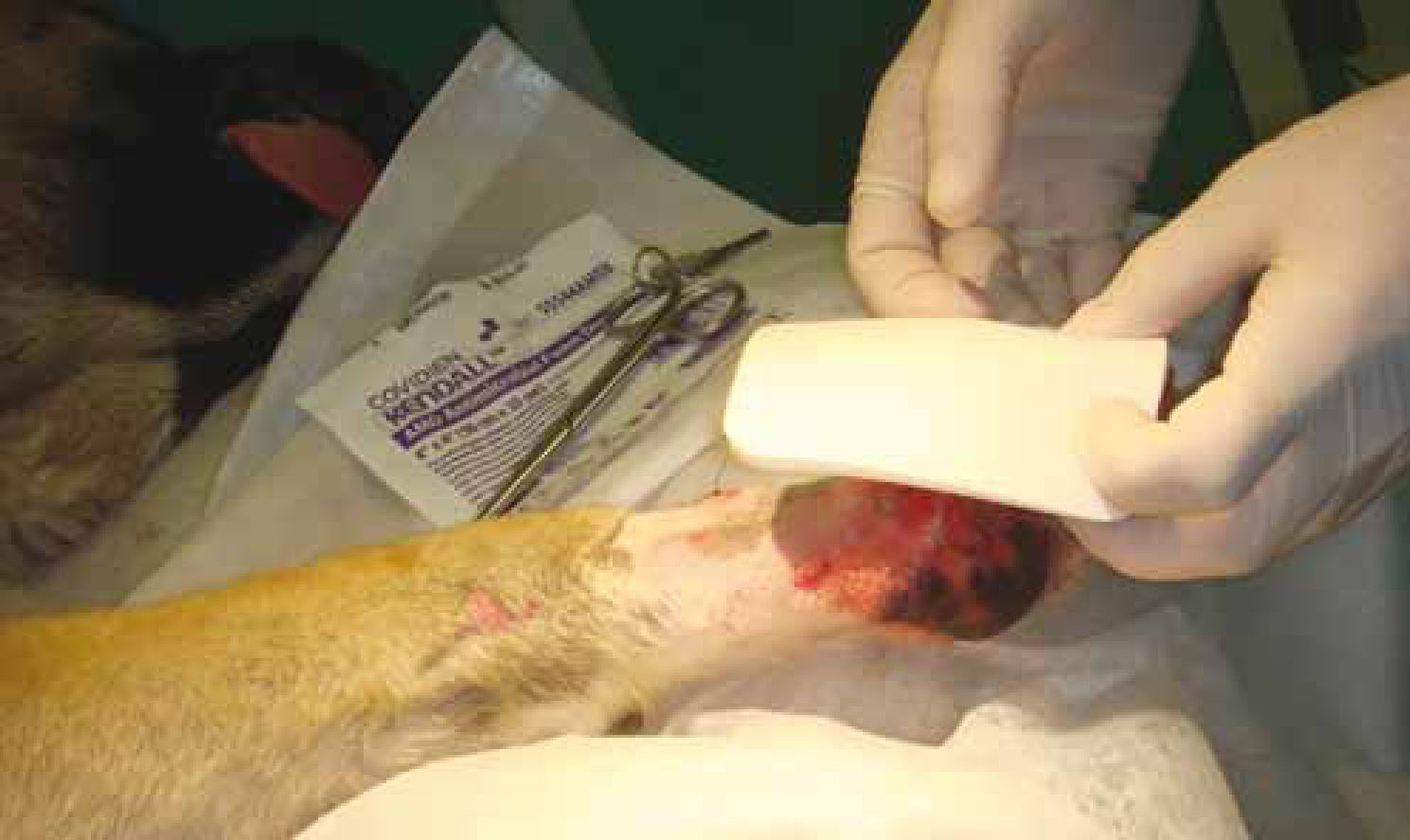
Conclusion
Maximising patient care and promoting successful healing and health is a major nursing goal, therefore it is vital that the RVN keeps up to date with current techniques to achieve such goals. With wound management forming a vital part of veterinary nursing practice, it becomes essential for the RVN to be able to confidently select and apply the most suitable wound dressings to their patients. There is no single wound dressing that can provide an optimal healing environment throughout the entire duration of the wound healing process. Therefore, it becomes imperative for the RVN to monitor the wound's progression carefully and to select the most appropriate wound dressing to support and promote wound healing throughout each stage of the healing process.

